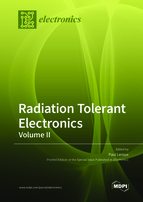Radiation Tolerant Electronics, Volume II
A special issue of Electronics (ISSN 2079-9292). This special issue belongs to the section "Microelectronics".
Deadline for manuscript submissions: closed (30 June 2022) | Viewed by 27181
Special Issue Editor
Interests: analog and mixed-signal IC design; RF; radiation effects; radiation hardening by design
Special Issues, Collections and Topics in MDPI journals
Special Issue Information
Dear Colleagues,
Research on radiation tolerant electronics has increased rapidly over the last few years, resulting in many interesting approaches to model radiation effects and design radiation hardened integrated circuits and embedded systems. This research is strongly driven by the growing need for radiation hardened electronics for space applications, high-energy physics experiments such as those on the large hadron collider at CERN, and many terrestrial nuclear applications, including nuclear energy and safety management. With the progressive scaling of integrated circuit technologies and the growing complexity of electronic systems, their ionizing radiation susceptibility has raised many exciting challenges which are expected to drive research in the coming decade. Even though total ionizing dose effects in bulk CMOS is well known, still little is known on the radiation performance of advanced (FD-)SOI and FinFET technologies. Regarding single-event effects, the continued scaling has drastically increased the number of multiple-transistor or multiple-cell upsets which requires new solutions to reduce the error rate in digital and mixed-signal ASICs but also for FPGAs. Radiation hardness assurance of complex systems with multiple components in mixed technologies also necessitates new testing paradigms and verification methodologies to limit the time and cost for evaluation.
The main aim of this Special Issue is to seek high-quality submissions that highlight emerging applications, address recent breakthroughs in modeling radiation effects in advanced electronic devices and circuits, the design of radiation hardened analog, mixed-signal, RF and digital integrated circuits and radiation hardness testing methodologies. The topics of interest include, but are not limited to:
- Basic mechanisms of radiation effects in electronic devices
- Compact modeling of radiation effects and circuit/layout level optimization (TID and SEE)
- Radiation effects in power devices/circuits
- Design of radiation hardened integrated circuits (analog/RF/mixed-signal/digital)
- Radiation hardening and fault tolerance in FPGAs
- Radiation hardness assurance testing
Prof. Dr. Paul Leroux
Guest Editor
Manuscript Submission Information
Manuscripts should be submitted online at www.mdpi.com by registering and logging in to this website. Once you are registered, click here to go to the submission form. Manuscripts can be submitted until the deadline. All submissions that pass pre-check are peer-reviewed. Accepted papers will be published continuously in the journal (as soon as accepted) and will be listed together on the special issue website. Research articles, review articles as well as short communications are invited. For planned papers, a title and short abstract (about 100 words) can be sent to the Editorial Office for announcement on this website.
Submitted manuscripts should not have been published previously, nor be under consideration for publication elsewhere (except conference proceedings papers). All manuscripts are thoroughly refereed through a single-blind peer-review process. A guide for authors and other relevant information for submission of manuscripts is available on the Instructions for Authors page. Electronics is an international peer-reviewed open access semimonthly journal published by MDPI.
Please visit the Instructions for Authors page before submitting a manuscript. The Article Processing Charge (APC) for publication in this open access journal is 2400 CHF (Swiss Francs). Submitted papers should be well formatted and use good English. Authors may use MDPI's English editing service prior to publication or during author revisions.






